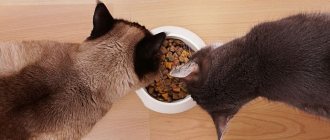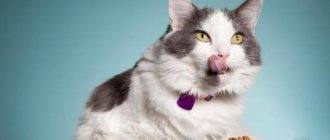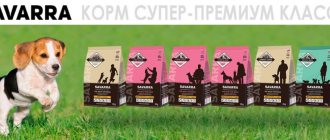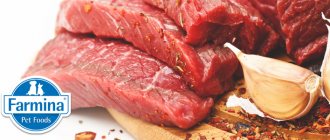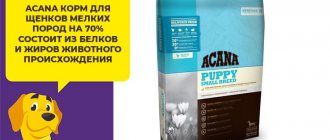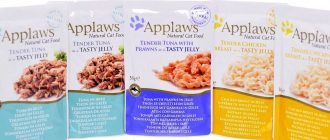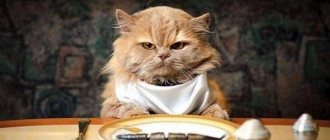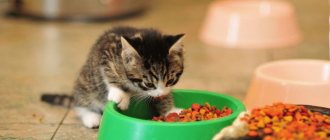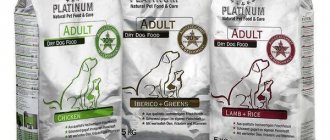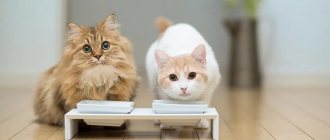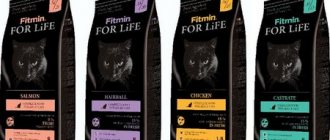How and what to feed Persian cats correctly? These beauties are the most beautiful of the domestic cat family. These are magnificent animals with an absolutely individual, memorable and easily recognizable appearance. The most successful attempt by a person to create an “eternal kitten” with a sweet short face and an unusually easy-going disposition. The Persian lifestyle is leisurely and measured. These cats sleep 18-20 hours a day. And it seems that they - melancholic by nature - are not interested in anything in the world! But this is far from true. In fact, they are closely observing everything that is happening through the barely opened eyelids of bottomless round Persian eyes.
Nutritional features of Persian cats
Persian cats should be given a balanced diet. Their daily menu should include foods rich in proteins, vitamins, fats and carbohydrates.
As you know, proteins in the animal’s body are broken down into amino acids. The latter, in turn, are extremely necessary in the construction of biological tissues, for example, bone and muscle, skin and claw plates. Therefore, protein products are indispensable in the diet of a Persian cat.
With an insufficient amount of arginine (it is not synthesized by the Persian body), serious problems begin with energy metabolism, metabolism, brain function and the gastrointestinal tract.
Taurine is also considered a necessary component for the cat's body. It helps maintain good functioning of the cardiovascular system, and also prevents eye diseases, to which Persians are so prone.
Carotene cannot be produced by the Persian cat's body, so the animal can only obtain this component necessary for health with vitamin complexes or industrial food.
Do not forget that Persians are prone to urolithiasis. Excessive amounts of mineral salts contribute to the appearance of conglomerates, so it is recommended to limit foods such as milk and fish in the diet of this breed.
In addition, the pet owner should follow the following rules:
- It is strictly forbidden to mix wet and dry ready-made food. The interval between meals of these two types of food should be at least 10-12 hours. If you do not heed this advice, your Persian may experience digestive disorders. Moreover, “individual” nutrition increases the load on the Persian’s liver.
- You should also not mix food from different manufacturers, for example, mousses and pates, or diets that take into account age and individual characteristics - dry food for kittens and sterilized cats, etc.
- There should be an interval between meals of homemade food and finished industrial products. It is worth waiting until it is completely digested.
- The share of wet food in the total volume of food for Persian cats should not exceed more than 25%.
Combing wool
Many experts believe that you need to comb your cat with a so-called slicker brush, but this is one of the most common mistakes. Slickers can be used only in exceptional cases, and it is better not to use such extreme options for grooming in household use. Caring for the hair of a Persian cat begins with the purchase of a good comb, preferably one that is made of steel and whose teeth are long, but not sharp, so as not to injure the animal.
It is better to accustom your animal to daily brushing from a very tender age. If you follow simple rules, caring for your animal will become a habit and will not cause negative emotions.
No cat will immediately sit still and wait to be brushed.
Diet
Just like other pets, Persian cats should eat at approximately the same times. Although Persians are very gentle and vulnerable animals, they need to be taught discipline. The cat should have a single place for eating; it should not be taught to take tasty things from the hands of the owner.
The number and volume of servings directly depends on the age of the cat:
- up to one month – feeds on mother’s milk as needed;
- 1-2 months – up to 6 times a day;
- 2-4 months – the number of meals is reduced to 4-5 times;
- 4-6 months – the animal is transferred to three meals a day;
- from 10 months – can be switched to adult cat mode – 2 times a day.
The daily intake for a Persian baby is calculated according to the formula: 250 g per 1 kg of live weight. For an adult, this norm can increase by 100 g.
Ear and eye care
Due to their long fur, Persians' ears and eyes require regular grooming. Animals' ears should be cleaned weekly with a cotton swab moistened with a special product for caring for cats' ears.
The eyes of Persians constantly secrete a transparent tear secretion. If it is not removed, it can dry out in the form of crusts or leave marks on the face in the form of streaks. To prevent tear secretion from accumulating and drying, it must be removed with a napkin soaked in a special eye care product.
Natural food for a small Persian
In fact, up to two months of its life, the little press feeds exclusively on mother's milk. Then they gradually begin to introduce him to adult food, but there is no need to rush into this, because the baby’s gastrointestinal system is very delicate. Experts call the best period for the first complementary feeding 5-6 weeks of life.
To begin with, you can introduce the kitten to porridge. It should be boiled in milk diluted with water. In order for the baby to easily “cope” with such food, the porridge needs to be not hot (up to 37℃) and very liquid. Of course, you shouldn’t add salt or sweeten the dish.
At about the age of 3 months, it is recommended to start giving your baby frozen meat. Naturally, you first need to defrost it, pour boiling water over it and chop it as much as possible with a knife. A single dose of this product for a baby up to 4 months is 0.5 teaspoon. Vegetables should be introduced last, since the Persian kitten’s body does not immediately accept them well.
Starting from 5 months, you can introduce foods such as cottage cheese, yogurt, and quail eggs into the diet. It is also allowed to give pets a variety of meat, cereal, vegetable, and cottage cheese mixtures intended for children.
Dry food begins at six months. Until the kitten learns to chew it normally, it is recommended to pre-soak the granules in warm water or meat broth. Special premium wet food for kittens is also allowed from 4-6 weeks of age.
What to feed an adult Persian cat
Just like most other cats, Persians need to eat meat frequently. In their daily diet, the meat part should be at least 50-60%. The share of vegetables in the total volume should not be more than 30%, and cereals - more than 10-18%. The following group of products is included in the daily menu for natural feeding:
- Meat . The most beneficial benefits come from lean boiled or chopped raw meat - chicken (dietary low-fat parts, for example, brisket), rabbit, beef, veal, lamb.
- Offal . Pieces of raw cow stomach will be the most useful. Persians also love chicken kidneys and hearts. You should avoid chicken necks or bone sets.
- Fish . This product is not paramount for the Persian breed. You can feed your four-legged friend fish no more than once every two weeks. It is better to give preference to marine and low-fat varieties. It is generally better to avoid river fish.
- Dairy and fermented milk products . Persians consume kefir with great pleasure. The optimal percentage of fat content is 1%. You can also give cottage cheese; if desired, your pet can dilute it with a small amount of water or yogurt. Low-fat yogurt can also be given. But it’s better to avoid cow’s milk altogether. In Persian cats it often causes diarrhea and bloating.
- Vegetables . It is recommended to add zucchini, cauliflower, carrots, pumpkin, green beans, and beets to meat dishes.
- Eggs . Not all cats, including Persians, can cope with digesting chicken eggs. However, they are a source of protein necessary for the body. Therefore, quail eggs would be the best option. They can be given to cats both raw and boiled.
- Cereals. The most suitable from this group are rice, barley and buckwheat.
It is recommended to approach the choice of each product as responsibly as possible. Persians should only eat freshly prepared food. Given their sensitive digestive system, you should not leave “for tomorrow” what was not eaten on time.
How does a British kitten (2 months old) eat?
Milk is not a suitable food for all cat breeds, without exception. But British kids eat milk porridge with great pleasure. Rolled oats, semolina or buckwheat will do. Any fermented milk products are very useful; it is better to choose low-fat cottage cheese, yogurt, fermented baked milk, and sometimes a little sour cream. Cream (10%) two to three times a week will be very beneficial. You can give an egg yolk once every two to three days.
Many experts advise feeding kittens boiled, low-fat fish. Prepare soups for your pet, to which you can add finely chopped meat, grated cheese, liver, and beef heart. Chicken meat, boiled and chopped, is also perfect. As you can see, there are no particular differences; any breed of cat can be fed approximately according to the same scheme. But if there is intolerance to foods by representatives of your particular breed, the breeder must warn about this. When feeding natural food, kittens are given vitamin supplements daily: “Beofar”, Kitzim, “Farmovit”, “Doctor Zoo”.
Recipes for Persians
Persians love homemade cutlets. Of course, both in their composition and in the method of preparation, they differ significantly from those that people eat. The basis of the cat treat is dietary meat. It needs to be cut into pieces and boiled in clean water for approximately 10-17 minutes.
Separately, you need to boil any of the cereals (about 10-15 minutes). Both products must cool, and then it is recommended to mix them and form cutlets. The prepared semi-finished product must be stored in the refrigerator for 3 days. Before “serving” the cutlets need to be warmed up a little. The temperature of prepared dishes should not be more than 40℃.
You can also prepare your own wet food based on the type of production diet. To do this, you need to take 50% meat, 30% permitted vegetables and 20% cereals. Meat and cereal should be pre-cooked over a fire for 15-20 minutes. Vegetables can be added raw. Combine all components and mix. For greater benefit, you can add a small amount of olive or corn oil to this dish.
The best ready-made (industrial) rations
Ready-made industrial feeds from leading manufacturers help satisfy all the gastronomic needs of the Persians, as well as provide their bodies with useful microelements and vitamins. After analyzing the products available on the market, experienced veterinarians and breeders have compiled a list of the best foods for the Persian cat breed:
- Golden Eagle Holistic Adult Cat . Natural food from an American manufacturer. It contains approximately 32% of the protein Persians need. This product was a joint development of nutritionists, geneticists and veterinarians. Can be used by cats during pregnancy and feeding.
- Orijen Cat 6 Fresh Fish . Canadian granular product, characterized by a strong and pleasant smell for the animal. It contains different types of fish and a vitamin complex.
- Royal Canin Persian . A very appetizing French product created specifically for the Persian breed. It contains chicken meat, vegetables and grains. Prevents diseases of the digestive tract and ensures the beauty of the coat.
- Purina Pro Plan Delicate . Developed by Italian specialists specifically for those cats that have problems with the digestive system. More than 40% of the feed is protein. Also contains a vitamin complex.
- Bosch Sanabelle Hair. Offer from a manufacturer from Germany. The formula of this ready-made dish is designed specifically for long-haired cats. It has a positive effect on the digestive system and is made from poultry meat, rice and vegetables.
The ideal, according to many experts, would be industrial feed consisting of:
- pure meat – by 30-35%;
- plant fibers – up to 20%;
- protein natural filler – approximately 20%;
- offal or bone meal – up to 10%;
- natural oils;
- vitamin and mineral complexes.
If the owner decides to feed the cat commercial food (especially dry food), it is recommended to ensure that he drinks plenty of clean water.

